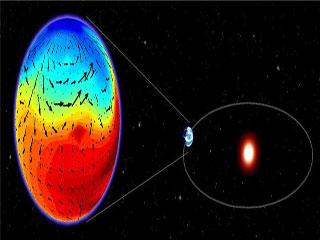
Schematic of the global climate model used to study Gliese 581d. Photo: LMD/CNRS.
WASHINGTON (BNS): The exoplanet Gliese 581d is the first planet outside our solar system, who has shown possibilities of life in it, scientists confirmed on Monday.
The plant has liquid oceans, flipping climate which shows its potential to create a life like Earth.
The discovery of the first habitable planet has become a quest for many astrophysicists who look for rocky planets in the "habitable zone" around stars, the range of distances in which planets are neither too cold nor too hot for life to flourish.
The larger and more distant Gliese 581d, which has been shown to be the confirmed potentially habitable exoplanet by Robin Wordsworth, François Forget and co-workers from Laboratoire de Météorologie Dynamique (CNRS, UPMC, ENS Paris, Ecole Polytechnique) at the Institute Pierre Simon Laplace in Paris.
Although it is likely to be a rocky planet, it has a mass at least seven times that of Earth, and is estimated to be about twice its size.
The astrophysicists also checked the climate of the exoplanet and found a dense carbon dioxide atmosphere -- a likely scenario on such a large planet -- the climate of Gliese 581d is not only stable against collapse, but warm enough to have oceans, clouds and rainfall.
Its atmosphere would store heat well, where it heats the planet effectively due to the greenhouse effect of the CO2 atmosphere, combined with that of the carbon dioxide ice clouds predicted to form at high altitudes.
Scientists are particularly excited by the fact that at 20 light years from Earth, Gliese 581d is one of our closest galactic neighbours.
For now, this is of limited use for budding interstellar colonists -- the furthest-travelled human-made spacecraft, Voyager 1, would still take over 300,000 years to arrive there.
 Previous Article
Previous Article Next Article
Next Article













The Indian Air Force, in its flight trials evaluation report submitted before the Defence Ministry l..
view articleAn insight into the Medium Multi-Role Combat Aircraft competition...
view articleSky enthusiasts can now spot the International Space Station (ISS) commanded by Indian-American astr..
view article